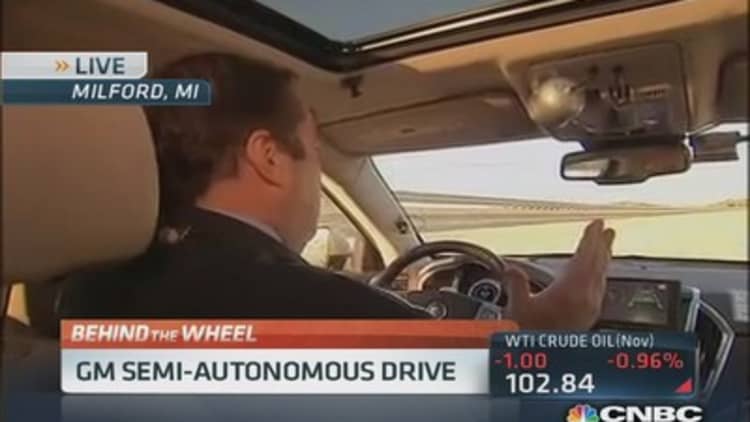
Slide behind the wheel and hit the gas on the Cadillac SRX test vehicle with "Super Cruise" and it feels like any other luxury SUV. However, when you hit 50 mph it feels different.
At that point, you hit two buttons on the steering wheel to activate Super Cruise, you position the SRX in the lane and take your hands off the wheel. After that, Super Cruise takes over.
"It's a pretty remarkable feeling isn't it?" asked Eric Raphael, manager of the General Motors Super Cruise program, who sat in the passenger seat next to me.
As we zipped around the GM test track in Milford, Mich., I was in the driver's seat but my hands were off the steering wheel and my feet didn't touch the gas or brake.
"Some of this technology, like adaptive cruise control, is already in some Cadillac models," said John Capp, GM director of electrical systems. "Our plan is to have the whole system available by the end of this decade."
Race for self-driving cars
General Motors has been working on autonomous drive technology for years. Some of the technology has gone into features like adaptive cruise control, which automatically starts braking as sensors detect your car is closing in too quickly on the car in front of you.
The next frontier is developing cars that completely drive themselves.
(Read more: Owner of flaming Tesla defends the car)
"There's a lot of momentum with this technology. Nobody wants to be left behind," said Raj Rajkumar, professor of electrical engineering at Carnegie Mellon University in Pittsburgh. "In 2003, if you'd have said that someday we'd see self-driving cars, you would have been labeled 'insane.'"
The crazy talk ended when everyone saw the Google car safely tooling around on public streets with researchers from the tech giant not steering or controlling the car.
Since then, nearly every automaker has proclaimed their intention to build self-driving cars.
Nissan and GM said they'll have one by the end of the decade. Elon Musk is shooting to have a Tesla with "co-pilot" technology to assist drivers by 2017.
"This technology is all very natural, very incremental, but it is coming," said Rajkumar.
(Read more: New brand rankings show select automakers on top)
What to expect and when
Rajkumar and his team have been working with GM and other automakers for several years. When I asked him to look into the future and predict what type of technology we'll see in our cars over the next decade, his expectations were clear.
"By 2018, you should be able to drive on the highway and the car will handle steering, speed and lane control. By 2020, your car will do lane changes and we'll see more features to handle stop-and-go traffic in urban areas. Ten years from now, cars will be communicating with street lights and other vehicles to help with traffic flow," explained Rajkumar.
(Read more: Safe!: This car model tops crash avoidance tests)
He added, "As the cars become smarter, one day you'll look up and not be driving."
Still, Capp said it's unlikely we'll ever see cars on the road without someone in the driver's seat.
"The level of technology is not going to all of a sudden take a quantum leap overnight where you can sit in the backseat of the car and let it take you to work," he said. "The driver is still going to have to pay attention."
—By CNBC's Phil LeBeau. Follow him on Twitter @LeBeauCarNews.
Questions? Comments? BehindTheWheel@cnbc.com.


